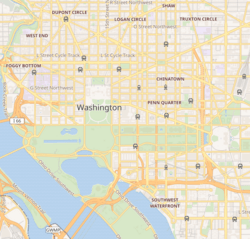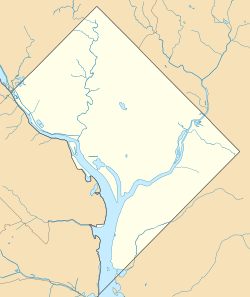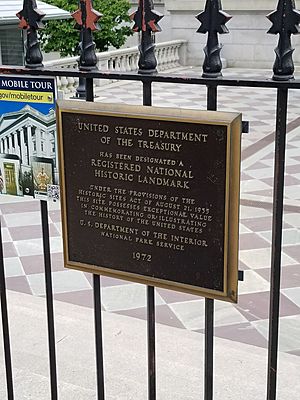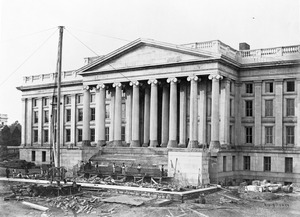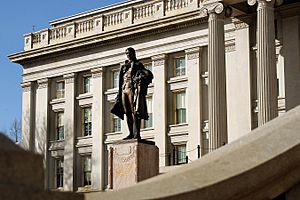Treasury Building (Washington, D.C.) facts for kids
|
U.S. Department of the Treasury
|
|
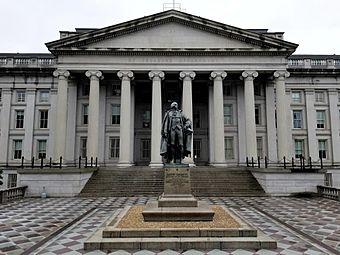
North entrance of the Treasury Building, with the statue of Albert Gallatin, in 2017
|
|
| Location | 1500 Pennsylvania Avenue, NW Washington, D.C. |
|---|---|
| Built | 1836-1842 (East Wing and Central) 1855-1861 (South Wing) 1862-1864 (West Wing) 1867-1869 (North Wing) |
| Architect | Robert Mills (East Wing and Central) Ammi B. Young and Alexander H. Bowman (South Wing) Isaiah Rogers (West Wing) Alfred B. Mullett (North Wing) |
| Architectural style | Neoclassical |
| NRHP reference No. | 71001007 |
Quick facts for kids Significant dates |
|
| Added to NRHP | November 11, 1971 |
| Designated NHL | November 11, 1971 |
The Treasury Building is a very important building in Washington, D.C.. It's where the United States Department of the Treasury works. This department helps manage the money for the United States. You might have even seen the building before, because a picture of it is on the back of the United States ten-dollar bill! It's also a special place called a National Historic Landmark.
Contents
A Look Back: The Treasury Building's Story
First Homes of the Treasury
In the year 1800, the capital of the United States moved. It moved from Philadelphia to a new area along the Potomac River. President John Adams said the government should be ready for business by June 15, 1800.
When government workers arrived in Washington, only one building was ready. This was the first Treasury Department building. More than half of the 131 federal workers worked there. It was a two-story red brick building. It had 16 rooms on the first floor and 15 rooms on the second. The building was about 147 feet long and 57 feet wide. It was near the President's House, which is now called the White House.
Just six months after opening, a fire broke out. This happened on January 20, 1801. The fire almost destroyed the building. It started on the first floor and burned upwards. Luckily, it was put out before too much damage happened.
The building was fixed, but by 1805, it was getting too small. The department had too many records. So, a new "fireproof" brick vault was planned. It was added to the west side of the building. Architect Benjamin Henry Latrobe designed this addition. It was finished in 1806.
This fireproof vault was very strong. It was the only part of the building that survived. This was when British troops attacked Washington in 1814. They burned many important buildings during the War of 1812. Treasury offices moved to other buildings for a while. The Treasury building was rebuilt by 1817.
On March 30, 1833, the Treasury Building caught fire again. A man named Richard H. White set the fire. He wanted to destroy some records. Volunteers saved many records, especially from the strong Latrobe vault. The Treasury offices moved again. After this fire, architect Robert Mills drew pictures of the old building. He wanted to record its design.
Building the Current Treasury Home
Designing the New Building
After the 1833 fire, Robert Mills drew plans for a new Treasury building. He also suggested it should be more fireproof. Mills won a design contest. President Andrew Jackson chose him to oversee the new Treasury building. Construction started on September 7, 1836.
There were disagreements about the building. Some people in Congress wanted to tear down the partly built East Wing. This was in January 1838. Another architect, Thomas U. Walter, looked at the building. He wrote a report that was critical of Mills' design. Mills defended his work. A vote was held in Congress to demolish the building. It was a very close vote, but the bill failed. So, work on the Treasury building continued.
The first parts of the current Treasury building were finished in 1842. These were the East Wing and the center sections. The most striking part of Mills' design is the huge, 350-foot-long Greek-style colonnade. This is the row of columns facing 15th Street. By 1844, the light brown stone was painted white. This was to protect the stone. The White House was also painted white for the same reason. Mills wanted to add more wings to the building. But he was removed from his job in 1851.
Adding More Wings
By the early 1850s, the Treasury building needed to be bigger. Mills updated his earlier plans. But there was more disagreement about his designs. Another architect, Thomas U. Walter, was asked to review Mills' plans. Walter then drew his own designs. His drawings showed a West Wing for the first time. This would make the building a closed rectangle shape. Walter's design was chosen. Robert Mills left his job at the Treasury Department.
In 1853, Ammi B. Young became the main architect for the Treasury Department. He had to combine different design ideas for the new South Wing. It became clear that both a South and West Wing were needed. Building both at the same time would save money. In 1855, digging began for the South Wing's foundation.
By 1857, the South Wing was partly built. Digging for the West Wing also started. But then, the country faced money problems in 1858. Construction on all federal buildings stopped. This was because Congress did not give enough money. Before the stop, the South Wing had many large stone columns. Some weighed as much as 33 tons each! But money problems were not the only challenge. By 1860, it looked like the country was heading toward a war.
After President Abraham Lincoln was assassinated in 1865, President Andrew Johnson moved his offices. He worked temporarily in the Treasury building. This was while the Lincoln family moved out of the White House.
Art and Statues
Sculptures at the Treasury
A famous artist named James Earle Fraser created two important statues. One is a statue of Alexander Hamilton. He was the very first Secretary of the Treasury. This statue stands in front of the building's south side.
The other statue is of Albert Gallatin. He was the fourth Secretary of the Treasury and served the longest. His statue stands at the northern entrance, facing Pennsylvania Avenue.
Images for kids


